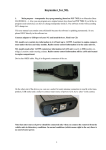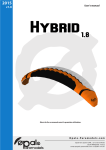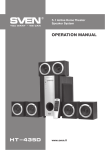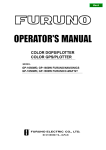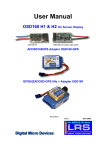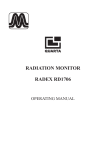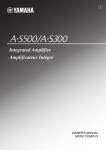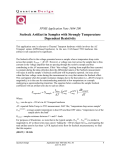Download Temperature Analysis System «Digital Flow
Transcript
Temperature Analysis System «Digital Flow - 2» User Manual Manual V1.4 ENG Copyright © 2008-2009 Vladimir Afanasiev E-mail: [email protected] WWW: www.digflow.ru Manual V1.4 ENG Copyright © 2008-2009 Vladimir Afanasiev E-mail: [email protected] WWW: www.digflow.ru Page 1 General usage and key construction principles The temperature analysis system «Digital Flow-2» is designed to measure and monitor air temperature fluctuations. «Digital Flow-2» system was specifically designed to locate ascending air flows in aeromodelling sports. The temperature analysis system «Digital Flow-2» consists of a fast-acting and high-sensitivity temperature sensor and portable receiver device. The sensor should be positioned on a mast in a remote location away from the place where an airplane model is being launched, and the receiver device can be placed in any location convenient for the user. Measured data is transferred from the sensor to receiver using a digital radiochannel of a fixed frequency. Each sensor is assigned a unique code for its radiochannel, which allows several sensors to work simultaneously. The data transfer process implements a noise cancelling algorithm for error detection and correction1. The three button interface on the receiving device allows users to change the settings and work-mode of the device. Transferred data is first processed by the microprocessor in the receiver, and then results are displayed on its graphical LCD display as a numbers and temperature graph. Ascending air flows can be then determined by the visual analysis of temperature fluctuations on this graph. Sensor - technical specifications Temperature sensor sensitivity Temperature range The response time on temperature fluctuations Number of reads per second Output power of transmission device Transmission frequency Voltage Current Size - 0.01 ºC - 0 – 61.44 ºC - t 0.5 – 0.6 Sec 2, t 0.9 – 7 Sec 3 -4 - 6.0 mW - 433.92 MHz - 1.6 – 3.3 V (2x ААА – Uptime: 2-3 days) - 18-40 mA - 57 x 49 x 24 mm (2.24'' x 1.92'' x 0.94'') Receiver - technical specifications LCD graphical display Temperature unit values on Y axis Displacement velocity of graph on X axis Period of time for complete refresh of graph Maximum operational length Voltage Current Size 1 - dimension 133 x 64 Pixels, monochrome - 0.16, 0.32 4, 0.64, 1.28, 2.56, 5.12, 10.24 ºC - 0.2 – 4 Pixels/Sec; step 0.1 - 19.2 – 384 Sec. - 300 met (328 yd). - 0.9 – 1.5 V (1x ААА – Uptime: 3-4 days) - 20-35 mA - 88 x 57 x 17 mm (3.46'' x 2.24'' x 0.67'') Implemented in versions of «Digital Flow -2» 2.16 ECC and higher. Warning! Receivers and sensors of version 2.15 (and lower) are not compatible with receivers and sensors of version 2.16 ECC and higher. 2 Period of time it takes sensor to change its readings by 50% from the difference in current and applied temperature. 3 Period of time it takes sensor to change its readings by 90% from the difference in current and applied temperature. 4 When using the values of 0.16 and 0.32, if T changes by 0.01 ºC, graph size changes by 4 and 2 pixels, respectively. Manual V1.4 ENG Copyright © 2008-2009 Vladimir Afanasiev E-mail: [email protected] WWW: www.digflow.ru Page 2 The interface of receiver device Tavg 24.98 ∆T 0.02 S Tsens 25.00 R 4x Yc 48.0 Button 1 Button 2 Button 3 R S Power On/Off Icon description Power source: - Battery low - Receiver - Battery low - Sensor Graph smoothing: 2x, 4x – 2x or 4x graph smoothing is turned on Signal transmission: Y – No errors in transferred data. YE – Fatal errors (could not recover). YID – Sensor with a different ID is in close distance. YC – Errors were corrected. Interface functionality and data display Button 1 — Allows users to sequentially view and select programmable settings and then return to the graph display mode. Button 2 — Allows changing settings. In the graph display mode, it allows changing the degree of graph smoothing (2x or 4x). Button 3 — Allows changing settings. In the graph display mode, this button sequentially turns on/off display of the following values: period of time for a complete graph refresh, scale for values on Y axis. Numerical values that are displayed on the screen: Tsens — Current air temperature in ºC. Tavg – average temperature, which is calculated as an arithmetic average of all values over the period of time for a complete graph refresh. ∆T – the difference between Tsens and Tavg. Setting up the device To install batteries in the sensor or receiver, it is necessary to unscrew the fixing bolts located on end faces of their frames and separate each frame into two halves. AAA size batteries, or rechargeable batteries, should be used in these devices. Batteries have to be installed in accordance to their polarity, and then the device frame has to be assembled back. Both the sensor and receiver can be turned on/off in any order. When the sensor is turned on, the electric engine for blowing air should start working. To extend the battery life, sensor's microprocessor initiates data transfer only when an alteration in temperature was detected. After receiver-register is turned on, it starts displaying air temperature, measured by the sensor, and building the temperature graph. Signal quality can be monitored and controlled using the «Y» icon on the display. When it doesn't change or blink, it indicates that data is being continuously transferred. If the sensor code doesn't match the code of the receiver, or if the receiver is close to a sensor with a different ID, the «YID» icon is displayed. The «YE» icon is displayed in case of fatal errors that could not be corrected. «YС» icon is displayed if errors were successfully corrected. The receiver can be placed on ones wrist using the wristlet on this device. «Digital Flow -2» allows monitoring battery charges. If the sensor's or receiver's battery is discharged, there will be an icon in the form of battery displayed on the screen. It may have a «R» and/or «S» index for receiver or sensor, respectively. In order to locate ascending air flow using «Digital Flow -2» it is necessary to have a mast (tower), with the length of at least 5 m (5.46 yd). Sensor has to be mounted on the top of this mast. A plastic fishing line of a matching size can be used as a mast. However, installing sensor on a fishing line made of carbon fiber, or metal, is not recommended because these types of materials can screen the signal. As a result, the signal transfer distance and operational length can decrease. As an option, the top part of the carbon fiber fishing line can be replaced with a wooden or fiber-glass rod. Sensor has to be mounted to this rod using rubber hoops attached to the back of the device. The inlet of temperature sensor has to be pointing downwards. Manual V1.4 ENG Copyright © 2008-2009 Vladimir Afanasiev E-mail: [email protected] WWW: www.digflow.ru Page 3 Receiver settings Settings can be changed after pressing Button 1. They are then listed sequentially by pressing this button. Warning: power can be turned off only when device is in graph display mode. Power button is blocked when viewing or changing settings, and it is necessary to return to the graph display mode to turn off the device. Programmable parameters: 1. «Y Axis Range» – Selection of the temperature scale for Y axis. The scale should be selected based on weather conditions. If Configuration temperature fluctuations are significant and temperature graph is not Y Axis Range – 0.64 °C fully displayed on the screen, then the scale value needs to be modified and increased. In the opposite case, if the amplitude of temperature fluctuations is insignificant, then a more sensitive scale needs to be selected. The following scale values are supported: 0.16, 0.32, 0.64, 1.28, 2.56, 5.12, and 10.24 °С, where each value is the maximum height of the graph on Y axis. Therefore, if scale value is set to 0.64 °С, the Y axis is going to be 0.32 °С in its positive direction and -0.32 °С in its negative direction from 0 °С scale mark. Pressing Button 2 selects the previous value, and pressing Button 3 selects the next value for the scale range. Pressing Button 1 saves the selected value into battery-independent memory and switches to the next configuration parameter. When device is in graph display mode, the value of Y Axis Range is displayed in the top right corner, and it can be turned on or off using Button 3. 2. «Update Speed» — The refresh rate, or the speed at which Configuration the graph is being shifted on X axis. «Update Speed» is a period of Update Speed – 0.5 sec time at which the graph is shifted on one Pixel to the right and a new X Axis Range – 48.0 sec value is calculated. Values can range from 0.2 to 4.0 Sec with an increment of 0.1 Sec. Pressing Button 2 allows selection of a higher value, and pressing Button 3 allows selection of a lower value. The value for «Update Speed» parameter has to be determined based on wind's speed and distance from sensor's mast to the location of the airplane model start, or based on personal preference. In the case of strong winds, it is recommended to set a high value for the «Update Speed» parameter. If the «Update Speed» is slow, it might be necessary to activate graph smoothing. Smoothing is performed based on two (2x) or four (4x) consequential readings of temperature by calculating their arithmetic average. Note that after smoothing option is enabled, it would apply to all points on the graph only after its complete refresh. «X Axis Range» — The period of time it takes to completely refresh the graph. This value is autocomputed by microprocessor based on the «Update Speed» parameter. The average temperature (Tavg) is calculated over “X Axis Range” time period, and the microprocessor recalculates Tavg every time there is an incoming value from the temperature sensor. Tavg is then set as a zero point on Y-axis. As a result, when temperature increases, the graph line goes up, but the whole graph is shifted downwards. This is rather convenient because there is no need to manually adjust the zero point on the graph with temperature fluctuations. When device is in graph display mode, the value of “X Axis Range” is displayed in the top right corner and it can be turned on/off using Button 3. 3. Contrast – The contrast of LCD display. Pressing Button 2 increases the contrast, and pressing Button 3 decreases it. 4. Sensor ID – Individual code of a transmitting sensor, Configuration which can range from 0001-9999. This property allows the selection Sensor ID – 0001 of a sensor, which then will be used for measuring temperatures. Each sensor has its unique ID code, which is assigned during manufacturing and can't be further changed. All register-receiver devices are identical. They can be setup to received signal from any Manual V1.4 ENG Copyright © 2008-2009 Vladimir Afanasiev E-mail: [email protected] WWW: www.digflow.ru Page 4 sensor with a known ID code that is located in the operational range. Pressing Button 2 selects the value's order (one of four digits) that can be then modified. The selected digit appears underlined on the screen. Pressing Button 3 sets the value of this digit, which ranges from 0-9. The general procedure for detecting ascending air flow Air mass with a higher temperature relative to the surrounding air has a lower spec. gravity or density and therefore ascends. This lies in the principle of the formation of ascending air flows. The Sun warms up a certain region of the Earth's surface, in the process forming a warm air mass. When this air mass reaches a certain temperature, affected by the wind, it rises from the Earth's surface ascending in the wind's directional flow. The sportsman then has to locate the formation and take-off of the ascending air flow using the graph, or has to locate the already formed air flow in the area where the sensor was installed. In order to correctly detect the ascending air flow, the sensor's mast has to be as tall as possible. Near the ground air has a higher turbulence, which decreases the accuracy of detecting warm and cold air masses. In addition to this, the closer the sensor is to the ground, the more distant it is from the center of ascending air flow; the final formation of which happens at a height of several dozen meters from the ground. Therefore, the sensor's mast height has to be 8-10 meters or higher from the ground. When setting up the sensor's mast, it is necessary to account for the wind's speed and desired time period from locating the ascending air flow to launching the model. If the wind is weak, the mast has to be positioned about 5-10 meters from the model's launching position and against the wind. If the wind is strong, the mast has to be positioned in a more distant location. Generally, the mast has to be positioned by practical considerations. The distance from the model's launching position to the mast has to be big enough to provide time for launching the model. The model has to gain altitude before the ascending airflow would reach the zone of model's start. The relation between temperature graphs and weather conditions 1. Even weather (this and the next graph were obtained with Y Axis Range – 0.64°С): Tsens 25.00 48.0 Tavg 24.97 ∆T 0.03 2. Air warms up and forms an ascending thermal air flow: Tsens 25.45 Tavg 25.07 ∆T 0.38 48.0 Manual V1.4 ENG Copyright © 2008-2009 Vladimir Afanasiev E-mail: [email protected] WWW: www.digflow.ru Page 5 3. The air mass took-off or was blown away by the wind. This type of graph gives the most indicative signal for launching an airplane model: Tsens 25.35 48.0 Tavg 25.17 ∆T 0.18 4. Descending air flow: Tsens 24.86 48.0 Tavg 25.17 ∆T -0.31 The figures above show general temperature graphs obtained using the «Digital Flow-2» system. These type of graphs were recognized by many well known people in aeromodelling sports as the most common indicators for the discussed weather conditions. The «Digital Flow-2» allows you to design better methods for locating ascending thermal airflows. In any case, locating ascending air flows has never been so easy, simple, and convenient as with the «Digital Flow-2» system. We wish you good luck and the best results! Manual V1.4 ENG Copyright © 2008-2009 Vladimir Afanasiev E-mail: [email protected] WWW: www.digflow.ru Page 6 Possible malfunctions of «Digital Flow -2» system and resolution methods Malfunction / Error The cause A graph on receiver device is not within the range of the Y Axis scale. The battery discharge indicator with the «S» index is showing. The contrast of LCD display on receiver device is low. The battery discharge indicator with the «R» index is showing. The working range of the system at one place is smaller than in the other. Temperature graphs are displayed with high discrepancy. One of the following indicators are illuminated: «YE», «YС», or «YID». The receiver device showing «Error». is The image on the LCD display doesn't change, device doesn't respond to pressing buttons. When pressing the power button, receiver device doesn't respond. Resolution Strong battery discharge. Batteries were Replace batteries inside the not replaced on a timely basis. sensor. It is suggested to change batteries right after the discharge indicator was illuminated. Strong battery discharge inside receiver. Replace batteries inside the Batteries were not replaced on a timely receiver device. It is suggested basis. to change batteries right after the discharge indicator was illuminated. 1. Strong radio emission on the system's 1. Change the distance from frequency, or close to it. In the past, it sensor to receiver device. was determined that the working range Change the position of the could decrease when using the system system. close to CDMA-2000 stations that use 2. Position your sensor and the frequency of 450 MHz. receiver device far from other 2. Several sensors are located in the sensors. Control the quality of range of you receiver device. Other transmitted signal using the sensors are closer than your sensor and signal indicator on the device. suppress the signal. When there are no letters showing, it indicates the strongest signal. 1. The measured temperature is out of 1. To prevent system damage it must be used in its work range from 0- 61.44°С. temperature range. 2. The sensor was damaged by a foreign 2. Sensor needs to be replaced. object, which penetrated the box through the temperature inlet opening. Error in the program of receiver device. Take batteries out of receiver device for several seconds, and then insert them back.










